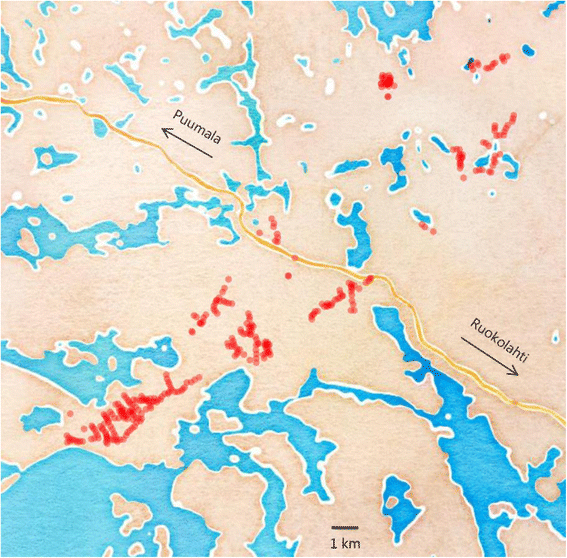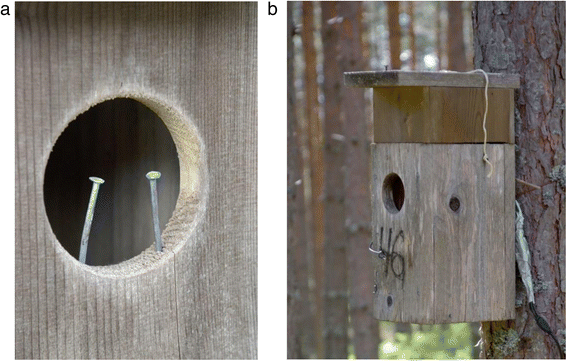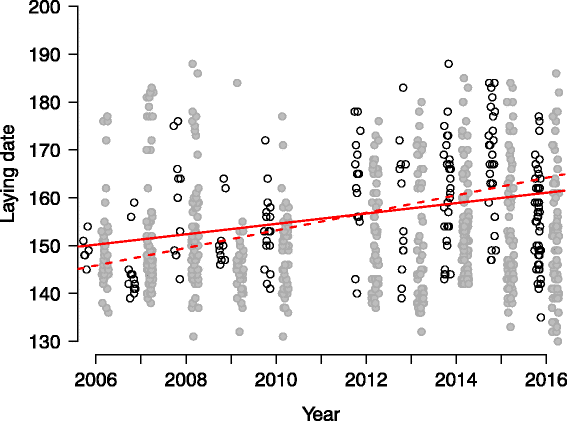The common redstart as a suitable model to study cuckoo-host coevolution in a unique ecological context
- PMID: 27887566
- PMCID: PMC5124271
- DOI: 10.1186/s12862-016-0835-5
The common redstart as a suitable model to study cuckoo-host coevolution in a unique ecological context
Abstract
Background: Co-evolutionary arms-races result in spatio-temporally dynamic relationships between interacting species, e.g., brood parasites and their avian hosts. However, majority of avian co-evolutionary studies are limited to "snap-shots" of a single breeding season in an open-nesting host. In a long-term study (11 breeding seasons), we explored a unique system between the brood parasitic common cuckoo (Cuculus canorus) and its host, the common redstart (Phoenicurus phoenicurus) which is exceptional among all cuckoo hosts due to being a cavity nester. Conditions in cavities are different from open nests, e.g., lower risks of predation, more favourable microclimate, increased risks of unsuccessful eviction of host offspring by the cuckoo nestling. Different conditions in cavities thus can be expected to shape parasite-host coevolution differently from what is typically studied in open nesting hosts.
Results: In our highly parasitised nest-box population (32.5%, n = 569 nests) only 35.7% of cuckoo eggs were laid into the nest cup and incubated by redstarts. Host nests shifted availability to later into the breeding season from 2006 to 2016 and cuckoos followed this trend by also shifting their timing of parasitism. Although previous studies revealed that redstarts selectively eject experimental non-mimetic eggs (desertion was not a specific response to foreign eggs), the hosts never ejected naturally-laid cuckoo eggs or cuckoo eggs cross-fostered into naturally non-parasitised nests. We solve the long-standing debate about the origin of cuckoo eggs found on the nest rim: we gained the first direct video-recording evidence that eggs found on the nest rim were mislaid by parasites and not ejected by hosts. Naturally-parasitised nests were deserted more often (18.6%) than control non-parasitized nests (5.6%) or nests artificially parasitised by us (1.4%). This suggests that the sight of the laying cuckoo female is the primary cue that triggers egg rejection (by desertion) in this host. Review of data from this and other study sites (10 populations, n = 853 experiments) demonstrates high variability in rejection rates and shows that populations facing higher parasitism rates reject parasitic eggs with higher frequencies. Surprisingly, cuckoo chicks either growing solitarily or with redstart chicks did not differ in their fledging success.
Conclusions: We suggest that the redstart is an ideal model system to study the flexibility and limits of brood parasite-host co-evolution in an extreme ecological setting.
Keywords: Arms-races; Co-evolution; Defence; Mimicry.
Figures



Similar articles
-
Fitting different visual models to behavioral patterns of parasitic egg rejection along a natural egg color gradient in a cavity-nesting host species.Vision Res. 2020 Feb;167:54-59. doi: 10.1016/j.visres.2019.12.007. Epub 2020 Jan 17. Vision Res. 2020. PMID: 31958715
-
Brood parasitism selects for no defence in a cuckoo host.Proc Biol Sci. 2011 Sep 22;278(1719):2777-83. doi: 10.1098/rspb.2010.2629. Epub 2011 Feb 2. Proc Biol Sci. 2011. PMID: 21288944 Free PMC article.
-
First evidence of regular common cuckoo, Cuculus canorus, parasitism on eastern olivaceous warblers, Hippolais pallida elaeica.Naturwissenschaften. 2007 Apr;94(4):307-12. doi: 10.1007/s00114-006-0189-8. Epub 2006 Dec 12. Naturwissenschaften. 2007. PMID: 17160581
-
Polymorphism at the nestling stage and host-specific mimicry in an Australasian cuckoo-host arms race.J Anim Ecol. 2023 Jan;92(1):30-43. doi: 10.1111/1365-2656.13849. Epub 2022 Dec 11. J Anim Ecol. 2023. PMID: 36426636 Review.
-
Cuckoos, cowbirds and hosts: adaptations, trade-offs and constraints.Philos Trans R Soc Lond B Biol Sci. 2007 Oct 29;362(1486):1873-86. doi: 10.1098/rstb.2006.1849. Philos Trans R Soc Lond B Biol Sci. 2007. PMID: 17827098 Free PMC article. Review.
Cited by
-
Eggshell spots are an important cue for the egg retrieval behavior in two tit species.Anim Cogn. 2023 Sep;26(5):1697-1703. doi: 10.1007/s10071-023-01814-w. Epub 2023 Jul 27. Anim Cogn. 2023. PMID: 37500983
-
Anthropogenic Habitat Loss and Fragmentation May Alter Coevolutionary Progress as Examined in a Brood Parasitism Model.Ecol Evol. 2025 Jul 16;15(7):e71721. doi: 10.1002/ece3.71721. eCollection 2025 Jul. Ecol Evol. 2025. PMID: 40671722 Free PMC article.
-
Random egg laying in host nests, rather than egg-matching, explains patterns of cuckoo parasitism: a comment on Zhang et al. (2023).Proc Biol Sci. 2023 Sep 13;290(2006):20231018. doi: 10.1098/rspb.2023.1018. Epub 2023 Sep 13. Proc Biol Sci. 2023. PMID: 37700656 Free PMC article. No abstract available.
-
Revealing the roles of egg darkness and nest similarity for a cryptic parasite egg versus host's cognition: an alternate coevolutionary trajectory.Proc Biol Sci. 2023 May 10;290(1998):20230103. doi: 10.1098/rspb.2023.0103. Epub 2023 May 3. Proc Biol Sci. 2023. PMID: 37132235 Free PMC article.
-
Defences against brood parasites from a social immunity perspective.Philos Trans R Soc Lond B Biol Sci. 2019 Apr 1;374(1769):20180207. doi: 10.1098/rstb.2018.0207. Philos Trans R Soc Lond B Biol Sci. 2019. PMID: 30967090 Free PMC article. Review.
References
-
- Feeney WE, Welbergen JA, Langmore NE. Advances in the study of coevolution between avian brood parasites and their hosts. Annu Rev Ecol Evol Syst. 2014;45:227–246. doi: 10.1146/annurev-ecolsys-120213-091603. - DOI
-
- Davies NB. Cuckoos, cowbirds and other cheats. London: T. & A. D. Poyser; 2000.
-
- Davies NB, Brooke ML. An experimental study of co-evolution between the cuckoo, Cuculus canorus, and its hosts. I. Host egg discrimination. J Anim Ecol. 1989;58:207–224. doi: 10.2307/4995. - DOI
MeSH terms
LinkOut - more resources
Full Text Sources
Other Literature Sources

